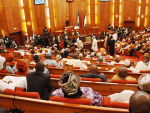FG Spends N7.1trn On Debt Service In 8 Years
The federal government has spent a whopping N7.1 trillion on debt servicing alone in the last eight years, LEADERSHIP checks have revealed.
The figure is cumulative of the amount spent on retirement of domestic and foreign loans incurred by the federal government between 2010 and 2017, but excludes statutory transfers.
It was also gathered that the N7.127 trillion is 70 per cent of (or about N5 trillion lower than) the 12.08 trillion budgeted for capital expenditure in the same period.
Debt service is the amount of money paid on the principal and interest on outstanding loans, the interest on bonds, or the principal of maturing bonds, which are usually incurred to fund capital projects or shore-up budget deficits.
Whereas debt service are on the first line charge from the federation account, the situation is different with capital and recurrent expenditures.
Government’s ability to finance its budgetary provisions for recurrent and capital expenditures is dependent on financial inflow to state treasury.
In 2015 and 2016, federal government’s spending on debt service were higher than the amounts spent on capital expenditures.
In 2015 for instance, N577.99 billion was budgeted for capital expenditure, but as at September of the same year, only N194.77 was actual expenses on capital projects against the N953 billion spent on debt servicing.
This was also the situation in 2016 when, out of the N1.59 trillion budgeted for capital expenditure, only N1.2 trillion was actually released for the purpose, compared to the N1.48 trillion paid to settle outstanding debts in the same year.
Minister of finance, Mrs. Kemi Adeosun said N1.2 trillion was spent on capital projects in 2016, leaving a balance of N39 billion deficit.
In the ministry’s 2017 budget, the federal government plans to spend N1.660 trillion on debt service, with N2.24 trillion budgeted for capital expenditure.
A breakdown of the figures shows that N1.552 trillion was earmarked for capital expenditure in 2014, while at the same time N712 billion was paid for debt service.
The N591.76 billion voted for loan repayment/service in 2013 when N1.54 trillion was budgeted for capital projects is higher than the N559.6 billion expenses on debt service in 2012. The sum of N1.52 trillion was budgeted for capital expenditure in 2012.
N1.56 trillion and N445.1 billion were voted for capital projects and debt service respectively in 2011, while N725 billion was used to service debt in 2010 against the N1.5 trillion budgeted for capital expenditure.
A chartered accountant and financial analyst, Mr. Peter Adebayo, said it is economically disastrous for the nation adding that “it portends a great danger for our economy”.
The senior partner at Adebayo & Co, an accounting firm said, “Spending 70 per cent of the amount expended on capital projects subject to accountability on debt servicing sincerely calls for forensic examination and this must be done without further delay, otherwise the nation will be plunged finally into the lagoon,”.
He blamed the lack of stewardship and accountability in the management of the country’s debt system for the high cost of public debt.
According to official records, the nation’s total debt profile (including foreign and domestic debts) now stands at N19.16 trillion as at March 2017.
Debt Management Office last week said N82.6 billion was spent in the first quarter of 2017 alone on servicing of domestic and foreign debts. $127.92 million or N39.19 billion, when calculated at the official exchange rate of N306.35 to $1, was used to service foreign debts, while another N434.87 was used to service local debts.
Nigeria had debt to Gross Domestic Product (GDP) ratio of 18 . 6 per cent as at December 2016, from the 12 . 1 per cent it was at the end of 2015, just as National Bureau of Statistics puts the nation’s GDP at N67. 98 trillion.
In a scary forecast, the International Monetary Fund (IMF) said Nigeria’s indebtedness will climb to 24.1 per cent of its GDP by 2018.
It made the pronouncement in its World Economic and Financial Surveys unveiled in May where it also projected that by the end of 2017, the country’ s current indebtedness would have reached 23.3 per cent of the GDP, which suggests that the cost of servicing the surging debt profile will further increase.
On the contrary, Minister of Budget and National Planning, Udoma Udo Udoma, expressed optimism that a coherent and clear approach has been set out in the recently launched Economic Recovery and Growth Plan (ERGP) to increase non-oil revenue and reduce the cost of debt service.
He argues that with improved revenue generation to the federation account, the debt ratio will consequently reduce.
Private investors or lenders measure a country’s ability to repay its debt by the level of its debt burden.
Borrowing from that, experts who spoke with LEADERSHIP urged the debt management office and the Central Bank of Nigeria to ensure prudent management of the nation’s debt profile.
Source: Leadership








